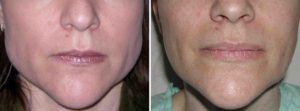The shape of the jawline has become a new area for facial enhancement in the past decade. As a u-shaped curve that makes up the lower third of the face, it is an acute transition line between the face and the neck. The jawline has numerous dimensional features including a desired curved or v-shape from one angle to the other and three easily seen and well-defined bony prominences, the chin and the two jaw angles. The width of the jawline is highly influenced by the size of the masseter muscles in the back end of the jaw. Deficiencies in any of the bony prominences or an irregular inferior border make for an undesired weaker jawline appearance. Large masseters muscles can make the jaw look too wide.
A smooth jawline is often age-related and the development of jowls, which everyone will eventually get, can be reversed by conventional facelifting techniques. A shorter chin and/or high jaw angles are the result of one’s genetics and are only affected to a minor degree by small amounts of bony atrophy with aging. Augmentation of the chin and jaw angles by synthetic implants can make dramatic changes in these bony prominences. Large thick masseter muscles are usually ethnic-related but some cases of hyperactivity do exist. Masseter muscle reduction defies a surgical procedure but chemodenervation can be very effective albeit a much longer term treatment.

Injectable fillers are intended to primarily plump up soft tissues such as lips and nasolabial folds but they can be used for bony augmentation. They can be easily and quickly injected onto the chin and at the jaw angles as an office procedure. Of all the injectable fillers, Radiesse is the best choice for jawline augmentation. It is not just because it is partially composed of hydroxapatite particles, which is the inorganic component of natural bone, but because of its greater persistence over most of the hyaluronic acid fillers. (e.g., Restylane) Its thicker viscous consistency also does a better job of pushing the overlying soft tissue away from the bone for a greater effect per volume of injected material.

Injectable jawline enhancement can be done by Radiesse filler in the chin and jaw angle and Botox into the masseter muscles. Its disadvantages are that neither is permanent and must eventually be repeated to maintain their effects. But for those opposed to more invasive surgery, non-surgical jawline modification is a viable alternative.
Dr. Barry Eppley
Indianapolis, Indiana


